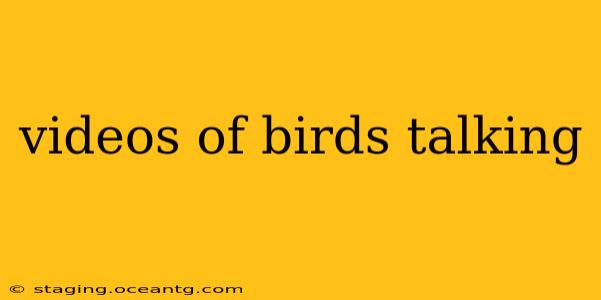The internet is awash with videos claiming to show birds "talking." While some videos might show birds mimicking human sounds, the reality of avian communication is far more nuanced and fascinating than simple conversation. This post explores the world of bird vocalizations, separating the entertaining videos from the scientific reality of how birds communicate. We'll dive into why some videos go viral, the science behind bird sounds, and what truly makes a bird's vocalizations unique.
Do Birds Really Talk?
The short answer is no, birds don't "talk" in the human sense. They don't possess the complex vocal cords and brain structures necessary for the nuanced articulation of human language. However, many bird species are incredibly adept at mimicking sounds they hear, including human speech. This mimicking ability is often mistaken for "talking," leading to the proliferation of viral videos.
Why Do Some Videos of Birds "Talking" Go Viral?
The appeal of videos showing birds seemingly "talking" is rooted in our innate anthropomorphism—the tendency to project human characteristics onto animals. Seeing a bird mimic human words taps into this inherent fascination, triggering emotional responses and prompting sharing. The novelty and surprise factor also contribute significantly to their virality. These videos often capitalize on our desire to connect with nature in a relatable way, even if the connection is a playful illusion.
What Sounds Do Birds Make and Why?
Birds communicate through a complex repertoire of vocalizations, including songs, calls, and other sounds. These sounds serve various purposes:
- Attracting mates: Many birds use elaborate songs to attract potential partners, showcasing their fitness and territoriality.
- Defending territory: Calls and songs are also used to warn off rivals and establish dominance.
- Contact calls: Birds use simple calls to maintain contact with their flock or family members.
- Alarm calls: These calls warn other birds of potential danger, such as predators.
The sounds produced are generated by a syrinx, a vocal organ located where the trachea splits into the lungs. Unlike human vocal cords, the syrinx allows many birds to produce two different sounds simultaneously. This contributes to the complexity and variety of bird vocalizations.
How Do Birds Mimic Human Speech?
The ability to mimic human speech varies greatly among bird species. Parrots, mynas, and some other species are particularly skilled at mimicking sounds. This ability is often linked to their intelligence and the complexity of their vocal learning mechanisms. They learn by listening to and repeating sounds, gradually refining their imitations. The mimicry isn't based on understanding the meaning of the words; it's simply an impressive feat of auditory learning.
What are Some Examples of Birds Known for Mimicry?
Several bird species are famous for their exceptional mimicry skills. These include:
- African Grey Parrots: Renowned for their vast vocabularies and ability to understand context in some instances.
- Myna Birds: Known for their exceptional ability to mimic a wide range of sounds, including human speech and other animal calls.
- Northern Mockingbirds: Masterful mimics, capable of imitating a vast array of sounds in their natural environment.
Are there any ethical considerations when it comes to birds and mimicry videos?
While many videos of mimicking birds are harmless, some raise ethical concerns. For instance, videos showcasing birds in captivity might promote unethical wildlife trade or neglectful practices. It's crucial to ensure that the birds in any video are being treated ethically and responsibly.
Conclusion:
While videos of birds appearing to "talk" are undoubtedly entertaining, understanding the true nature of bird communication adds a layer of appreciation for the complexity and wonder of the avian world. These amazing creatures communicate through a sophisticated system of calls and songs, and while some can mimic human speech, it's crucial to distinguish between mimicry and actual linguistic ability. By appreciating the nuances of avian vocalizations, we can further deepen our respect for these remarkable creatures and the intricate ways they interact with their environment.
